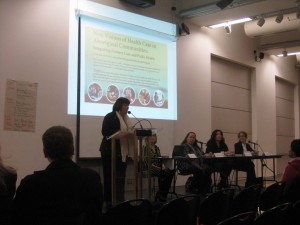Approximately 100 people attended a community event co-hosted by the Aboriginal Health Strategic Initiatives (AHSI) department with the Public Health Association of BC. The event entitled ‘New Visions of Health Care in Aboriginal Communities: Integrating Primary Care and Public Health’ was kindly sponsored by The Canadian Institutes for Health Research and was held on the evening of November 22nd at the Vancouver Public Library.
Some of the key messages from the panel presentations included:
- Primary care and public health are two areas that have the greatest potential as common first points of contact with the health care system to contribute to the reduction of health inequities for First Nations and Aboriginal peoples.
- Collaboration between primary care and public health can leverage resources and momentum towards investing in more equitable, socially just and wellness-centred population health outcomes for Aboriginal communities.
- Inter-sectoral collaboration at intrapersonal, interpersonal, organizational and systemic levels all support effective integration between primary care and public health.
- Health and wellness are not just the responsibility of health care systems, organizations or departments – multiple sectors (eg. education, industry & justice) have the potential to influence improved primary care and public health.
- Integration between primary care and public health for Aboriginal communities requires relationship building and open communication between partners. Often this requires groups to know each other well internally before establishing partnerships externally.
- The size and breadth of staff and services within a Health Authority is different when compared to a Health Centre in a First Nations community – each context influences how collaboration and integration across primary care and public health is pursued differently.
- The integration of health services has been common practice within health departments in First Nations communities for years and can serve as examples for how the mainstream health system can plan and provide health care services in a more coordinated fashion.
- Staff within health departments in First Nations communities often wear multiple hats and fulfill multiple roles within their jobs. Work as a result is less silo-ed.
- Both primary care and public health can jointly acknowledge and respond to the historical context of Aboriginal health outcomes in Canada through a culturally competent approach to health service planning and delivery.
- Definitions for and approaches to quality, respectful care can be shared across public health and primary care – working with Aboriginal community members to create this vision.
- The Provincial Health Service Authority’s Indigenous Cultural Competency Training program is an example of a resource that can benefit all staff working directly or indirectly with primary care and public health to build the necessary knowledge and skills to support First Nations and Aboriginal clients appropriately.
Thank you to all who attended the evening. To read the full summary of this event, please see the attached PDF document.

